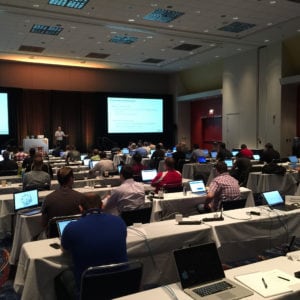Conference season is about to start, and it’s time to think critically. (No, that doesn’t mean yelling “BOO!” from the back row.)
Critical thinking (Wikipedia) means listening to what someone is saying, then analyzing the contents and coming to your own decision about the concepts involved.

When you’re listening to a conference session or keynote, ask yourself:
- Who does the speaker work for?
- On whose behalf is the speaker talking?
- Are they stating facts or opinions?
- If you wanted to prove their facts, how would you go about doing it?
- If you wanted to disprove their stance, how would you do that?
- What facts might they be omitting?
- What would their competitor say in response?
Example: Case Study Presentation
Bob, a database administrator for Acme Industries, gets up on stage. He talks about how his company recently adopted the Wonder Widgetizer 6000, and now their database transactions are 50% faster than ever before.
Now let’s think through what we just heard.
Bob works for Acme, and Acme probably has strict policies about what Bob’s allowed to say in public. For example, if Acme’s code sucks, Bob’s not allowed to say that.
Bob’s not there for free, either. Wonder Widgets likely paid Bob’s airfare, hotel, conference ticket, and a big expensive steak dinner. Bob’s got circles under his eyes because he got hammered with the Wonder Widgets sales crew last night.
Bob stated two facts:
- His company adopted the Wonder Widgetizer 6000
- Their database transactions are 50% faster
He didn’t say that those two things are cause and effect. Wonder Widgets may have sent a team of engineers to Acme to help performance tune their environment, and they may have also moved to a newer server that has more memory/CPU/SSD/whatever. Wonder may have even given them completely free licensing.
If you wanted to prove that the Widgetizer 6000 directly resulted in a 50% speed improvement, you would want to see that the hardware/code/workload was identical on both boxes. You would happily show those exact details onscreen to help prove your case. If those facts are missing, well…
Wonder’s competitors might look at the case study and say, “Best case scenario, it’s 50% faster. Our stuff is 500% faster, and it costs less, too, plus it offers these additional 5 features.” (Granted, you can’t take them at their word either.)
Critical thinking means connecting the dots.
Your boss sent you to a conference, and she expects something back in return. Maybe she wants you to have sharper skills, or to solve a particular problem, or to bring education back to the company.
The speaker up on stage has a boss too.
And that unseen boss needs to see some return on that investment.
And if you think attending a conference is expensive, think about how much it costs to buy a session spot or a keynote spot. What, you thought they gave those away for free? Vendors spend a fantastic amount of money to get onstage in front of you, and they need a specific return. That return is usually higher adoption rate and higher sales.
Critical thinking means understanding presentations – all of them – are designed to achieve a goal. Understand the goal of the session you’re watching, and analyze it with a clear head. Before you react (or heaven forbid, tweet or blog) to something you’re seeing on stage, think critically.


3 Comments. Leave new
I teach this simple formula at college, to my daughter and anyone who will listen: There are always three questions to ask yourself whenever someone is talking –
Who is telling me this?
What are they telling me?
Why are they telling me this?
I posted a blog on this a while back: https://buckwoody.wordpress.com/2015/09/30/on-being-skeptical-of-the-old-women-and-minorities/
Great info, Brent. Let’s keep it coming…
Hahaha, love it. Also: “Where did my pants go?”
What pants?